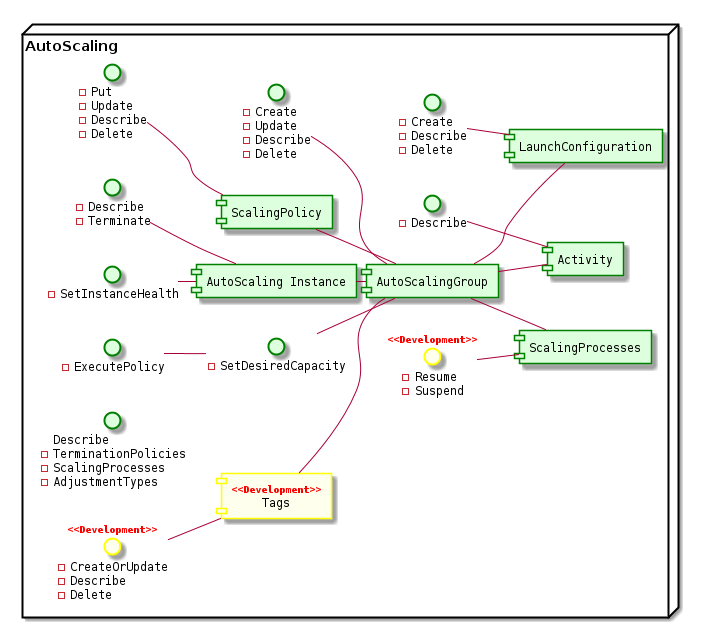-
Notifications
You must be signed in to change notification settings - Fork 0
autoscaling 3.3 spec
Feature consists of fundamental Autoscaling support implementing the AWS defined API. There are two primary use cases:
- Manual auto-scaling
- Action triggered auto-scaling based on custom metrics
- Register/Deregister instances with ELB
For 3.3 we only consider two kinds of scaling:
-
Manual : user controlled change to sizing of autoscaling group.
- SetDesiredCapacity allows the user to explicitly set the group size.
- ExecutePolicy allows the user to trigger the application of a scaling policy by hand.
-
Alarm/Policy based: user configures metric-based actions which trigger application of a scaling policy.
- MetricAlarms configured using PutMetricAlarm act as triggers.
- AlarmActions reference the ScalingPolcicy relative to the fully qualified AutoScalingGroupARN.
-
Second for 3.3
- Metric collection
- Scaling process control
-
Excluded from 3.3
- Notifications
- Operations requiring VPC support
- Anything requiring support for spot instances
- Schedule based scaling is not part of the 3.3 implementation plan.
- Operations needed for schedule based scaling must still be present and Describe operations must successfully return an empty response. This is needed to avoid breaking client tools.

- Required operations in topological order
- Operations for definiton a group
{Create,Describe,Update,Delete}AutoScalingGroup
- Running and health checking an instance in the group
- Operations for definiton a group


- Describes how to add instances instances
- AMI
- Instance Type
- Security Group
- Instance Key Pair
- Only one active launch configuration at a time
- Auto Scaling will terminate instances with old launch configurations first
- Rolling software updates
Auto Scaling managed grouping of EC2 instances Automatic health check to maintain pool size Automatically scale the number of instances by policy Min, Max, Desired Automatic Integration with ELB Automatic Integration with AZs Automatic distribution & balancing across AZs
Parameters for performing an Auto Scaling action Scale Up/Down By how much ChangeInCapacity (+/- #) ExactCapacity (#) ChangeInPercent (+/- %) Cool Down (seconds) Policy can be triggered by CloudWatch Events
Monitors a CloudWatch metric Threshold (> 50% CPU) Period (for 3 minutes) Alarm States OK - Within defined threshold ALARM - Outside defined threshold INSUFFICIENT_DATA - Metric does not have enough data to determine state Available Actions Trigger Auto Scaling Policy (scale up/down event) Send SNS notification
Instance Launch Instances are launched (not started) from a “gold” image Bootstrapping is important! Automatically added to ELB (if configured) Instance Termination Instances are terminated (not stopped) Longest running instance from the oldest launch config first Automatically removed from ELB (if configured) Cooldown The period after an Auto Scaling activity during which no other scaling activity can take place Gives the system time to perform and adjust to before executing a new scaling activity 300 seconds (5 minutes) by default Suspend/Resume Processes Allows you to manually suspend and resume Auto Scaling activities
See autoscaling-3.3-api-parameters
tag:rls-3.3
- Contact Info
- email: [email protected]
- IRC: #eucalyptus-devel (freenode)
- Twitter: @grrrze
- Other Links